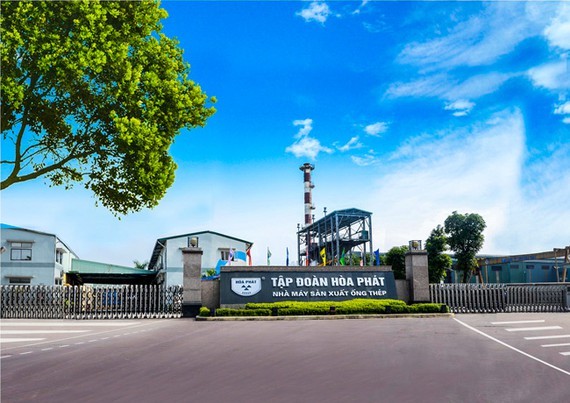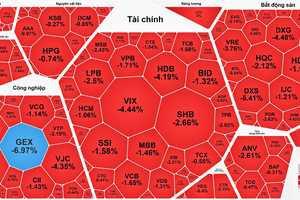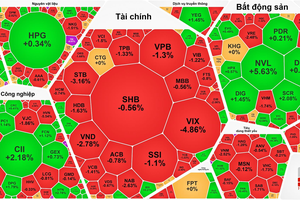
While HPG broke out with a profit of VND 6,977 bn, VNM dropped dramatically to VND 2,576 bn.
First quarter business results of nearly 370 listed companies announced by Rong Viet Securities (VDSC) show that results on both HoSE and HNX are positive with increasing profits of 62% and 100%, respectively. On HoSE, 58% of businesses recorded profit growth of about 20% compared with about 1% in the same period in previous years. Business results on HNX were similar when around 50% of enterprises recorded profit growth of almost 20%.
Steel consumption in the first quarter of the year grew strongly year-on-year in both export and domestic markets, helping steel companies such as the Hoa Phat Group Joint Stock Company (HPG) to show record high profits. According to the first quarter financial statement, HPG has surpassed the entire banking group to lead the market in profit after tax with VND 6977.6 bn, three times higher than in the same period in 2020. The sharp increase in steel price is also the reason for the Hoa Sen Group Joint Stock Company (HSG) to join the group of enterprises showing a trillion dong profit in the first quarter with VND 1,034 bn, five times higher than in the same period in other years.

Other companies among the Top 20 were a series of banks such as Vietnam Technological and Commercial Joint Stock Bank (TCB) with VND 4,397 bn; Military Commercial Joint Stock Bank (MBB) with VND 3,553 bn; Vietnam Prosperity Joint Stock Commercial Bank (VPB) with VND 3,201 bn; Joint Stock Commercial Bank for Investment and Development of Vietnam (BID) with VND 2,648 bn; Asia Commercial Bank (ACB) with VND 2,483 bn; HCM City Development Commercial Joint Stock Bank (HDB) with VND 1,563 bn; Vietnam International Commercial Joint Stock Bank (VIB) with VND 1,446 bn; Saigon-Hanoi Commercial Joint Stock Bank (SHB) with VND 1,330 bn; Tien Phong Commercial Joint Stock Bank (TPB) with VND 1,138 bn; and Orient Commercial Joint Stock Bank (OCB) with VND 1,011 bn.
Contrary to the spectacular growth of HSG was the dramatic decline of the two giants, Vietnam Dairy Products Joint Stock Company (VNM) and Vietnam Gas Corporation (GAS). VNM after-tax profit decreased by 7%, reaching VND 2,576 bn, while GAS profit decreased by 13%, reaching VND 2,029 bn. With this result, VNM fell to ninth place, while GAS was kicked out for the first time from the Top 10 most profitable companies on the stock market since it was listed on the stock exchange.
The financial reports submitted in the first quarter of this year recorded an unusual phenomenon with many businesses recording an increase in after-tax growth equal to, or even ten times higher than in the same period last year. Specifically, Tien Len Steel Corporation (TLH) showed an increase by three times; Vietnam Rubber Industry Corporation (GVR) by four times; Saigon Investment VRG (SIP) by five times; TKV Minerals JSC ( KSV) by six times; Tri Viet Securities (TVB) by eight times; Thu Duc Trading-Import Export (TMC) by nine times; Truong Thanh Energy and Real Estate JSC (TEG) by eleven times; NH Kien Long Commercial Joint Stock Company (KLB) by twelve times; Sesan 4 Hydropower JSC (S4A) by sixteen times; Bamboo Capital JSC (BCG) by twenty times; FLC Faros Construction JSC (ROS) by forty-four times; and the South Mekong Group JSC (VC3) by forty-six times.
Trick and manipulation
The strong recovery in business results in the first quarter was due to low results of the first quarter of 2020 when enterprises were suddenly affected by the Covid-19 pandemic. Even in the same period last year, many companies reported losses, but are now showing profits, so the growth rate calculated by times is not too difficult to understand. For the banking industry, the strong increase in profit in the first quarter included factors such as the contribution of credit growth and interest income, a sharp decline in provision costs for bad debts, and the effect of the policy of reducing operating costs after the second quarter of 2020.
However, this does not mean that beautifying of financial statements has declined. In fact, the first quarter financial statements are often doctored by companies to satisfy shareholders for the next AGM. According to an economist, the tricks to beautify the financial statements applied by SMEs are to use a lot of accounting estimates that have a direct impact on profit in the period.
Some common tips to increase profits are by reducing depreciation, provisions, inventory prices, provisions for bad debts, not recording expenses when assets are depreciated below net value, and capitalization of unqualified accounts. Profit tricking based on accounting estimates in fact do not increase profits, but merely convert profits in the following period to the current period.
The inevitable consequence is that next year profits will be reduced, and as there is no exact standard for the value of these estimates, it is seen as a powerful tool to highlight profits. In addition to using accounting estimates, an enterprise may also make a profit through mediating real transactions to increase profits for the current year, although such transactions may not benefit the company in the long run.
Investing in a group of shares with positive business results also has left investors facing high risks. It was a phenomenon that the stock price level was pushed up quickly in such a short time. This coincided with positive information of the removal of a liquidity bottleneck, stimulating profit taking activities. In fact, after reaching peak, many stocks sold out strongly, causing heavy losses for investors who bought in peak distribution sessions.
Therefore, to limit the risks, investors need to know how to read financial statements. Understanding financial statements will help investors evaluate the actual financial health of enterprises, find signs of potential risks to avoid, and seek genuine investment opportunities. When analyzing financial statements, investors can predict direction of future cash flow, revenue, and profit of the company, before making any investment decisions.
























